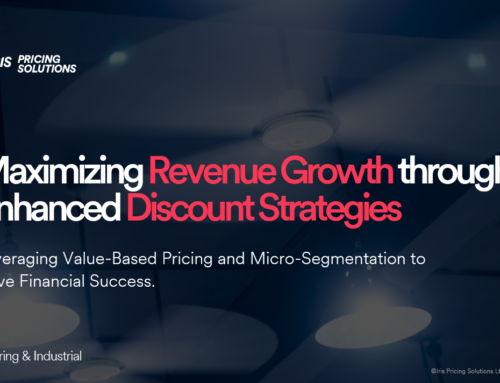By Greg Thomas, Vice President of Pricing Research & Insights at Pricing Solutions
The rapid growth of the development and commercialization of digital innovation is now commonly integrated across technologies and industries. Automation, the Internet of Things (IoT), machine to machine, connected technologies —these buzz words all define this new and exciting commercial space.
Healthcare, agriculture, manufacturing, resource extraction, logistics, transportation, facility management, food services and retail are just a few of the industries where digital innovation integrate technology to create value.
Examples of the technological innovation seen in these industries include improvements to:
- Conventional industrial equipment
- Computing hardware (sensors, Wi-Fi routers, servers, mobile devices)
- Software and middleware
- User applications
- Business services and consulting
- Mobile accessibility and control.
Technological advances enable businesses to increase productivity in these areas. We’re not talking about an incremental or linear improvement but a significantly large step change that fundamentally alters the organization’s business model, operating processes, capital and labor requirements, and interestingly the markets and customers they serve.
While these changes create challenges for innovating companies, one complication that is often unanswered is how digital innovation should be priced.
As companies move closer and closer to commercializing their digital offer, they run the risk of undervaluing the technology. To mitigate this risk, it’s important to develop a value-based pricing strategy and to consider this strategy from the onset of the advanced solution, rather than as an afterthought.
We recommend the following steps to help your organization determine a fair economic value for your advanced solution.
Take a Team Approach
Too often, advanced solutions are developed by teams of engineers, scientists, and developers without a commercial, marketing or sales perspective. For this reason, pricing is often not considered when the new product or service is being created, and the insights and opportunities that a pricing strategy could add to the digital innovation are overlooked.
Innovation is driven from a belief that the new cutting-edge product will add value to existing customers in some way, so it’s important that at the onset of the innovation process teams consider what a customer is willing to pay for the technology and what value it will add.
Too often these questions aren’t asked until the product has transitioned to the commercial team. Addressing pricing earlier on allows all stakeholders the opportunity to weigh in on these questions throughout all stages of technological development.
Determine Economic Value of Digital Innovation
There is little debate that the novel technologies will provide significant economic value to the customers that adopt it. However, there is less agreement about how much economic value is created for the end user and how the digital solution should be priced so that the company receives a ‘fair share’ of the economic value created.
If the company has typically applied a cost-plus pricing equation in the past, then they may believe that determining the economic value of the digital innovation is too difficult or not possible and thus advocate to continue using the cost-plus pricing approach for the sake of simplicity.
Not only is a cost-plus pricing strategy easier, but it’s also often perceived as “good enough,” because it’s efficient and is what has been done in the past. If so, why consider a different pricing strategy?
The problem is that cost-plus pricing doesn’t address the value side of the pricing equation, which means that this strategy may undervalue the new technology and sub-optimize the company’s investment.
While it is more difficult to determine the economic value customers will capture from making use of the digital solution, the company will be sub-optimizing their investment if they do not take the time to develop a value-based pricing strategy.
While a value-based pricing strategy is imperative to minimizing the risk of undervaluing digital innovation, it is complicated when the advanced offer is not sold directly to the end user.
In some cases, the innovation is sold through a distribution channel or to an OEM that is incorporating the digital solution into a broader offer. This challenge makes it even more important to invest in developing an understanding of how much economic value is created for the end user. Otherwise, your channel customer or partner may capture more than their fair share of the value of the solution given their closer relationship and knowledge of the end user.
Overcome Legacy Pricing Pitfalls
Once companies begin the process of developing a value-based pricing structure, other complicating issues may reveal themselves. These complications develop as the business team starts to assess the various elements of the digital solution.
A common problem is that many technologies like industrial equipment, computer hardware, and software, user applications, etc.… have elements with their own legacy pricing that has developed over time. Sometimes these elements have come from acquired companies and their pricing was developed under a very different business strategy and set of objectives. Other times, these elements are coming together after being developed and managed by different business units in the company. The history behind each element can create challenges around the development of consistent pricing and offer strategy and the eventual revenue allocation plan.
Follow Our Best in Class Approach

Despite the challenges, the best-in-class firms invest in a value-based pricing strategy. To overcome associated challenges, they start the development process for their price and offer structure early; often when the new innovation is still in the early development stage.
In these early days the price and offer structure will be more conceptual but so is the product, which allows the business team to map out very specific economic value drivers (like growing revenue or reducing capital expenditures) as well as use cases and customer segments that may derive the most value from the digital solution.
Tip: With use cases and customer segments it’s often most beneficial to consider customer size and value, but other factors like geography may come into play.Once these use cases and customer segments are defined then the business team should begin a series of customer research phases. Ideally, these research phases will progress in parallel to the actual development path of digital innovation.
Research Phase One – Getting Initial Customer Feedback
This relatively informal research phase can be conducted by the business team and often consists of direct discussions with loyal customers outlining the innovative product’s concept and gathering their feedback.
Tip: Be cognizant of how you describe the digital innovation to the customer, especially if it’s still in a conceptual phase of development. While this can be challenging, it’s critical that you get the communication right.In this phase, it is important to ‘listen for’ key words the customer uses to describe how the new innovative technology may or may not impact their business and productivity.
Tip: For some businesses, it is challenging to get in touch with the customer who is the true “end user” for the digital innovation, but it’s important to speak to the customer who would be the true decision maker and end user of the product to ensure that the feedback gathered is accurate and actionable.Research Phase Two – In-depth Customer Interviews
The next phase is a more formal research effort targeting very specific customer types done by expert customer researchers. This phase includes a complete overview of the offer and clearly defines its potential economic value drivers.
The researcher will conduct a series of individual interviews that aim to discover the customer’s current work effort that the digital innovation will be applied against. As best as possible quantification of this work effort should be captured and estimated in as much detail as possible.
It’s important to provide an overview of the new product, highlighting how it may impact the customer’s business and the economic impact it’s expected to drive.
Capturing the customer’s feedback regarding their level of certainty around the specific economic benefits expected from the advanced solution is critical. If the customer feels the economic estimates are overly optimistic then discuss what they feel is realistic instead.
During this in-depth customer interview, it is also important that the researcher explore different pricing models (like CapEx, OpEx or a mix of both) with the customer and understand which pricing models they feel would work the best with their business and the specific use case of the digital innovation.
With the information from this in-depth customer interview, the researcher and business team can develop an economic value model to quantify how much incremental economic value the new advanced solution produces relative to the customer’s current work effort and processes.
Research Phase Three – Quantitative Research
Many companies likely stop at this point as they have learned a significant amount about their potential customers, the economic value of the advanced solution and the type of pricing and offer structures their customers will find acceptable.
The return on investing in this process to determine the potential economic value of the digital solution is significant and will minimize the risk that the new offer is underpriced.
However, some companies may need to go further in the understanding of the potential economic value for multiple customer segments or industry segments. To do so may require an investment in a deeper quantitative study. These comprehensive studies work best in markets with numerous potential customers (hundreds to thousands).
The investment in this in-depth quantitative research is more significant as the development of a detailed survey is often required. At this point, the explanation of the digital solution must be even more detailed and survey questions should be focused on presenting alternative configurations, price models and price levels.
This additional investment will yield greater insight, but how can a company determine if this is a necessary step?
Companies that have a layered market or very large customer base should consider investing in quantitative research. If the digital innovation is being created for a new space or industry, or if it’s being created for a very competitive market then it’s important to do quantitative research to see how relevant the solution is considering the competitive offers that are available.
From a thorough quantitative survey, the research will yield data allowing the organization to assess potential customer preferences for different configurations of the advanced solution at different price points under different pricing model scenarios. Often a tiered pricing structure can be developed for the digital solution with the aid of these research insights.
Developing Pricing Structure for Long-Term Success
Given the significant investment firms are making into the development of digital innovation and the significant expected economic benefits they provide, it is only logical and good business practice to also invest in the development of a thoughtful pricing structure.
Developing a strategic pricing structure will help to minimize the risk that the new innovative solution is underpriced and will maximize adoption as customers will experience improved alignment with the value they receive, and the pricing model offered.
Contact us today to learn how to mitigate the risk of undervaluing your company’s digital solution.

“Best Practices in Monetizing the Internet of Things” Webinar
This webinar will present an overview of case studies and pricing best practices for IoT solutions. Join this webinar to learn how to efficiently price IoT innovations for the long-term revenue growth.





